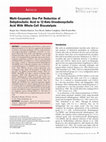Papers by Dirk Weuster-Botz

Biotechnology Letters, 2015
Objectives To investigate quantitatively and reproducibly a scalable, preparative crystallization... more Objectives To investigate quantitatively and reproducibly a scalable, preparative crystallization method in novel stirred tanks using three different protein solutions containing residual microbial host cell proteins (HCP). Results Lysozyme from solutions being spiked with up to 15 % host cell proteins (HCP) (corresponding to 176,500 ppm) was crystallized within a 2.4-4.6 h at 93.7 % yield using NaCl and glycerol. Lipase was crystallized under comparable conditions using NaCl and a mixture of two polyethylene glycols (PEG). Enhanced green fluorescent protein (eGFP) was overexpressed in E. coli yielding a solution containing 23 % target protein. Residual HCP content after pretreatment was 7-16 %. eGFP was crystallized from these solutions within 1.75-4 h at 88.7 % step yield using ethanol and the same mixture of two PEG as in the case of lipase. HCP contained in the solvent channels of the protein crystals could be removed by diffusive washing yielding final purities at or above 99 %. Preparative crystallization can be carried out with fast kinetics and high yields from solutions containing residual impurities and may represent an attractive alternative purification method compared to preparative chromatography, especially at large production scales.

Bioprocess and biosystems engineering, Jan 13, 2015
Optical chemical sensors are the standard for pH monitoring in small-scale bioreactors such as mi... more Optical chemical sensors are the standard for pH monitoring in small-scale bioreactors such as microtiter plates, shaking flasks or other single-use bioreactors. The dynamic pH range of the so far commercially available fluorescent pH sensors applied in small-scale bioreactors is restricted to pH monitoring around neutral pH, although many fermentation processes are performed at pH < 6 on industrial scale. Thus, two new prototype acidic fluorescence pH sensors immobilized in single-use stirred-tank bioreactors, one with excitation at 470 nm and emission at 550 nm (sensor 470/550) and the other with excitation at 505 nm and emission at 600 nm (sensor 505/600), were characterized with respect to dynamic ranges and operational stability in representative fermentation media. Best resolution and dynamic range was observed with pH sensor 505/600 in mineral medium (dynamic range of 3.9 < pH < 7.2). Applying the same pH sensors to complex medium results in a drastic reduction of re...
Tetrahedron: Asymmetry, 2009
... enhancement by medium engineering. Petra Gadler a , Tamara C. Reiter a , Kathrin Hoelsch b , ... more ... enhancement by medium engineering. Petra Gadler a , Tamara C. Reiter a , Kathrin Hoelsch b , Dirk Weuster-Botz b and Kurt Faber a , Corresponding Author Contact Information , E-mail The Corresponding Author. a Department of ...
Process Biochemistry, 2012
Metabolic Engineering, 2007
The increasing interest in studying enzyme kinetics under in vivo conditions requires practical m... more The increasing interest in studying enzyme kinetics under in vivo conditions requires practical methods to estimate control parameters from experimental data. In contrast to currently established approaches of dynamic modelling, this paper addresses the steady-state analysis of metabolic pathways. Within the framework of metabolic control analysis (MCA), elasticity coefficients are used to describe the control properties of a local enzyme reaction. The double modulation method is one of the first experimental approaches to estimate elasticity coefficients from measurements of steady-state flux rates and metabolite concentrations. We propose a generalized form of the double modulation method and compare it to the recently developed linear-logarithmic approach.

Journal of Molecular Catalysis B: Enzymatic, 2011
Abstract Mathematical models and simulations have become indispensable tools for the characteriza... more Abstract Mathematical models and simulations have become indispensable tools for the characterization and optimization of enzymatic processes. Nonetheless, industrially relevant enzymes are often poorly characterized with respect to enzyme kinetics. For the description of bisubstrate reactions catalysed by oxidoreductases in many cases Michaelis–Menten kinetics is used, which is a significant simplification. The NADPH-dependent 3-ketoacyl-(acyl-carrier-protein) reductase (KR) from Synechococcus sp. strain PCC 7942 is an interesting biocatalyst for the asymmetric synthesis of a variety of chiral building blocks, such as ethyl ( S )-4-chloro-3-hydroxybutanoate. Initial-rate analysis of the KR-catalysed reduction of ethyl 4-chloroacetoacetate to the corresponding ( S )-alcohol gave families of straight lines in double-reciprocal plots consistent with a sequential mechanism being obeyed. Product inhibition studies revealed that the KR follows a steady-state ordered Bi Bi mechanism with NADPH binding first. This result was corroborated by fluorescence enhancement studies, which indicated that the cofactor can bind to the free enzyme. The dissociation constants for the binary NADPH–protein complex determined kinetically and by fluorescence titration were identical within experimental error (1.04 ± 0.35 mM and 1.01 ± 0.23 mM) and confirmed the accuracy of the obtained kinetic parameters.

Journal of Biotechnology, 2012
As clear structure-activity relationships are still rare for ionic liquids, preliminary experimen... more As clear structure-activity relationships are still rare for ionic liquids, preliminary experiments are necessary for the process development of biphasic whole-cell processes involving these solvents. To reduce the time investment and the material costs, the process development of such biphasic reaction systems would profit from a small-scale high-throughput platform. Exemplarily, the reduction of 2-octanone to (R)-2-octanol by a recombinant Escherichia coli in a biphasic ionic liquid/water system was studied in a miniaturized stirred-tank bioreactor system allowing the parallel operation of up to 48 reactors at the mL-scale. The results were compared to those obtained in a 20-fold larger stirred-tank reactor. The maximum local energy dissipation was evaluated at the larger scale and compared to the data available for the small-scale reactors, to verify if similar mass transfer could be obtained at both scales. Thereafter, the reaction kinetics and final conversions reached in different reactions setups were analysed. The results were in good agreement between both scales for varying ionic liquids and for ionic liquid volume fractions up to 40%. The parallel bioreactor system can thus be used for the process development of the majority of biphasic reaction systems involving ionic liquids, reducing the time and resource investment during the process development of this type of applications.

Journal of Biotechnology, 1996
was produced in a fed-batch bioprocess with L-leucine auxotrophic Corynebacterium glutamicum stra... more was produced in a fed-batch bioprocess with L-leucine auxotrophic Corynebacterium glutamicum strains developed by genetic engineering. An efficient supply with nutrients was achieved by applying closed-loop control of glucose as the main carbon source, with a model-based, parameter-adaptive control strategy. This control strategy is based on an extended, semi-continuous Kalman filter for process identification and a minimum variance controller. The lab scale fed-batch process with C. glutamicum SMl and C. glutamicum DR17 pECM3::iluA38 was characterized with respect to biomass, product and by-product accumulation. A differential analysis of growth, specific productivities, and selectivities was performed to characterize the carbon flow over process time. Characterization of L-isoleucine transport steps across the cell membrane resulted in a balance of L-isoleucine transport over process time. Up to an extracellular L-isoleucine concentration of 140 mM the cytosolic L-isoleucine, provided by the biosynthesis, was quantitatively excreted into the medium via the export carrier system. Optimized feeding profiles for, L-leucine and phosphate in correlation with the on-line estimated glucose consumption were achieved up to the pilot scale (300-l stirred tank reactor). The maximum L-isoleucine concentration was 150 mM (21 g 1-l) with a space-time yield of 4.3 mmol 1 -' h -'. With a 98% closed carbon balance the selectivity for isoleucine was 14%, for biomass 13%, and for CO, 68%.
Journal of Biotechnology, 2005

Engineering in Life Sciences, 2011
The combination of hydrodynamically generated cavitation with disinfectants is a new approach for... more The combination of hydrodynamically generated cavitation with disinfectants is a new approach for disinfection of water. The aim of this study was to investigate the inactivation of Escherichia coli at high cell densities (∼107 cells mL–1) with a combination of hydrodynamic cavitation and chlorine dioxide. A new type of hydrodynamic cavitation reactor (micro wire mesh with downstream nozzle) was developed, which consumes 30% less energy than conventionally used orifice plates at similar flow rates. Compared with sole chlorine dioxide incubation the combination of chlorine dioxide with hydrodynamically generated cavitation resulted in a reduction of 50–70% of incubation time for 99% cell inactivation at an initial chlorine dioxide concentration of 0.25 mg L–1. The final viable cell number was reduced by a factor of 100–1000 compared to sole chlorine dioxide disinfection. An energy demand of ∼0.1–0.2 kWh m–1 is necessary to induce hydrodynamic cavitation at these optimum operation conditions (cavitation number of 0.13–0.17). Higher inactivation rates, the reduction of surviving cells by orders of magnitude compared to sole chlorine dioxide inactivation or the reduction of initial chlorine dioxide concentration compensate for the additional energy demand.
Computers & Chemical Engineering, 2008
A hybrid genetic algorithm-based method to solve constrained multi-objective optimization problem... more A hybrid genetic algorithm-based method to solve constrained multi-objective optimization problems is proposed. Considering operation around a steady state of a dynamical system, the task of the algorithm consists on finding a set of optimal, but constrained solutions. The ...

Chemical Engineering & Technology, 1997
A ‘carbon source controlled shift technique’ was developed for fermentation medium optimization i... more A ‘carbon source controlled shift technique’ was developed for fermentation medium optimization in continuous culture with the objective to maximize growth rate and growth‐linked product formation of a biological system. An automatic culture medium preparation system was operated together with 2 parallel stirred tank reactors and a HPLC system for on‐line analysis of the carbon source concentration in the reactors. A genetic algorithm was applied for experimental design. The concentrations of 7 medium components (mineral salts and vitamins) were optimized automatically within 40 continuous experiments to result in a maximum growth rate of the methylotrophic yeast Candida boidinii and growth‐linked production of the formate dehydrogenase enzyme (FDH). The specific growth rate of Candida boidinii and the specific activity of the FDH enzyme at a set‐point of 420 mM methanol in the reactor were, thus, improved by 19% to 0.16 h−1 and 26% to 164 U g−1, respectively, compared to the previo...

Biotechnology Progress, 2001
Based on an integrated approach of genetic engineering, fermentation process development, and dow... more Based on an integrated approach of genetic engineering, fermentation process development, and downstream processing, a fermentative chymotrypsinogen B production process using recombinant Pichia pastorisis presented. Making use of the P. pastorisAOX1‐promotor, the demand for methanol as the single carbon source as well as an inducer of protein secretion enforced the use of an optimized feeding strategy by help of on‐line analysis and an advanced controller algorithm. By using an experimental system of six parallel sparged column bioreactors, proteolytic product degradation could be minimized while also optimizing starting conditions for the following downstream processing. This optimization of process conditions resulted in the production of authentic chymotrypsinogen at a final concentration level of 480 mg·L−1 in the whole broth and a biomass concentration of 150 g·L−1 cell dry weight, thus comprising a space‐time yield of 5.2 mg·L−1·h−1. Alternatively to the high cell density fer...

Biotechnology Progress, 2011
Biotechnologically produced succinic acid has the potential to displace maleic acid and its uses.... more Biotechnologically produced succinic acid has the potential to displace maleic acid and its uses. Therefore, it is of high interest for the chemical, pharmaceutical, and food industry. In addition to optimized production strains and fermentation processes, an efficient separation of succinic acid from the aqueous fermentation broth is indispensable to compete with the current petrochemical production of succinic acid. Isolation and purification of succinic acid from an Escherichia coli fermentation broth were studied with two amine‐based reactive extraction systems: (i) trihexylamine in 1‐octanol and (ii) diisooctylamine and dihexylamine in a mixture of 1‐octanol and 1‐hexanol. Back extraction of succinic acid from the organic phase was carried out using an aqueous trimethylamine solution. The trimethylammonium succinate generated after back extraction was split with an evaporation‐based crystallization. The focus was on process integration, for example, reuse of the applied amines ...
Biotechnology Letters, 2007

Biotechnology Letters, 2007
The application of five water-soluble, halogen-free, alkylammonium-based ionic liquids (ILs) as a... more The application of five water-soluble, halogen-free, alkylammonium-based ionic liquids (ILs) as additives for advanced crystallization of lysozyme was investigated. Their biocompatibility was determined by long-term measurement of the overall mean relative enzyme activities. These were maximally reduced by about 10-15% when up to 200 g IL l À1 was added. Sitting-drop vapor diffusion crystallization experiments revealed that the addition of some of the ILs led to less crystal polymorphism and precipitation was avoided reliably even at larger NaCl concentrations. The addition of ILs tended to result in larger crystals. The kinetics of lysozyme crystallization were significantly enhanced using ILs as crystallization additives, e.g. by a factor of 5.5 when 100 g ethanolammonium formate l À1 was added. ILs with ''soft'' anions, such as formate or glycolate, were superior to ILs with ''hard'' anions, like nitrate.

Biotechnology Letters, 2007
The quantitative estimation of intracellular metabolite concentrations (metabolic profiling) is a... more The quantitative estimation of intracellular metabolite concentrations (metabolic profiling) is a prerequisite for a better understanding of biological processes and thus inevitable for the rational improvement of microbial production strains and process design. Since pool sizes of substrates regulate flux through different enzymes, the accurate determination of intracellular metabolite concentrations is necessary to understand in vivo reaction kinetics. Quantification of intracellular concentrations of glycolytic intermediates in Escherichia coli K12 was achieved by using a novel in situ rapid sampling and quenching procedure. A new extraction procedure using buffered hot water was established. By use of simultaneous multi-substrate feeding with various ratios of glucose, fructose and acetate during continuous cultivations several metabolic states were induced. Metabolic flux analysis and the newly developed metabolic profiling procedure were used to determine in vivo enzyme kinetics as exemplified for fructose 1,6-bisphosphate aldolase and citrate synthase.
Biotechnology and Bioengineering, 2006
A fuzzy-logic light attenuation model was developed and validated for a stirred-tank photobioreac... more A fuzzy-logic light attenuation model was developed and validated for a stirred-tank photobioreactor. Based on this model, local light intensities were used to calculate local specific growth rates of the cyanobacteria Synechococcus PCC 7942. The light regime for maximization of biomass space-time yield in a batch process was estimated using a genetic algorithm taking into account the integral average of the individual growth rates.

Biotechnology and Bioengineering, 2012
Ursodeoxycholic acid (UDCA) is a bile acid of industrial interest as it is used as an agent for t... more Ursodeoxycholic acid (UDCA) is a bile acid of industrial interest as it is used as an agent for the treatment of primary sclerosing cholangitis and the medicamentous, non‐surgical dissolution of gallstones. Currently, it is prepared industrially from cholic acid following a seven‐step chemical procedure with an overall yield of <30%. In this study, we investigated the key enzymatic steps in the chemo‐enzymatic preparation of UDCA—the two‐step reduction of dehydrocholic acid (DHCA) to 12‐keto‐ursodeoxycholic acid using a mutant of 7β‐hydroxysteroid dehydrogenase (7β‐HSDH) from Collinsella aerofaciens and 3α‐hydroxysteroid dehydrogenase (3α‐HSDH) from Comamonas testosteroni. Three different one‐pot reaction approaches were investigated using whole‐cell biocatalysts in simple batch processes. We applied one‐biocatalyst systems, where 3α‐HSDH, 7β‐HSDH, and either a mutant of formate dehydrogenase (FDH) from Mycobacterium vaccae N10 or a glucose dehydrogenase (GDH) from Bacillus subti...

Biotechnology and Bioengineering, 2011
Reduction and oxidation of steroids in the human gut are catalyzed by hydroxysteroid dehydrogenas... more Reduction and oxidation of steroids in the human gut are catalyzed by hydroxysteroid dehydrogenases of microorganisms. For the production of 12-ketochenodeoxycholic acid (12-Keto-CDCA) from cholic acid the biocatalytic application of the 12α-hydroxysteroid dehydrogenase of Clostridium group P, strain C 48-50 (HSDH) is an alternative to chemical synthesis. However, due to the intensive costs the necessary cofactor (NADP(+) ) has to be regenerated. The alcohol dehydrogenase of Thermoanaerobacter ethanolicus (ADH-TE) was applied to catalyze the reduction of acetone while regenerating NADP(+) . A mechanistic kinetic model was developed for the process development of cholic acid oxidation using HSDH and ADH-TE. The process model was derived by identifying the parameters for both enzymatic models separately using progress curve measurements of batch processes over a broad range of concentrations and considering the underlying ordered bi-bi mechanism. Both independently derived kinetic models were coupled via mass balances to predict the production of 12-Keto-CDCA with HSDH and integrated cofactor regeneration with ADH-TE and acetone as co-substrate. The prediction of the derived model was suitable to describe the dynamics of the preparative 12-Keto-CDCA batch production with different initial reactant and enzyme concentrations. These datasets were used again for parameter identification. This led to a combined model which excellently described the reaction dynamics of biocatalytic batch processes over broad concentration ranges. Based on the identified process model batch process optimization was successfully performed in silico to minimize enzyme costs. By using 0.1 mM NADP(+) the HSDH concentration can be reduced to 3-4 µM and the ADH concentration to 0.4-0.6 µM to reach the maximal possible conversion of 100 mM cholic acid within 48 h. In conclusion, the identified mechanistic model offers a powerful tool for a cost-efficient process design.









Uploads
Papers by Dirk Weuster-Botz